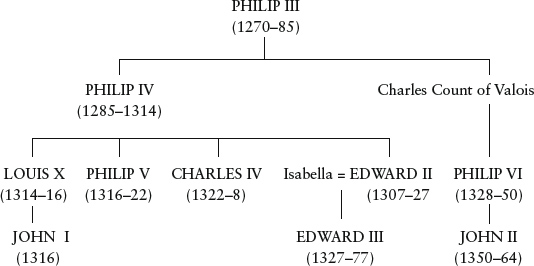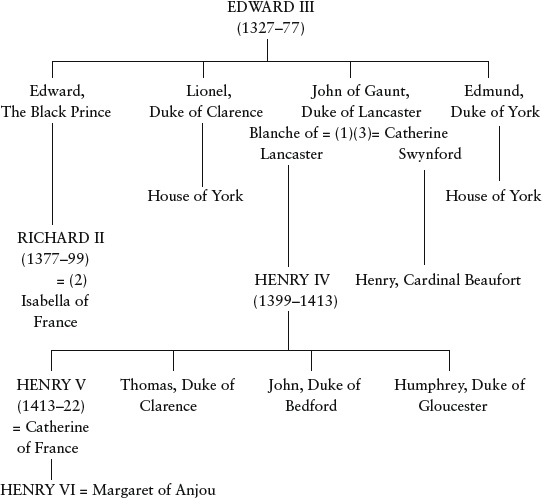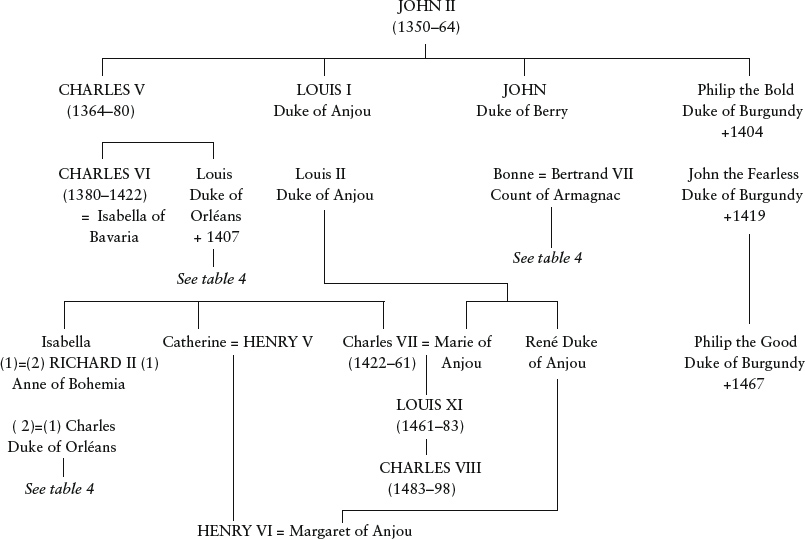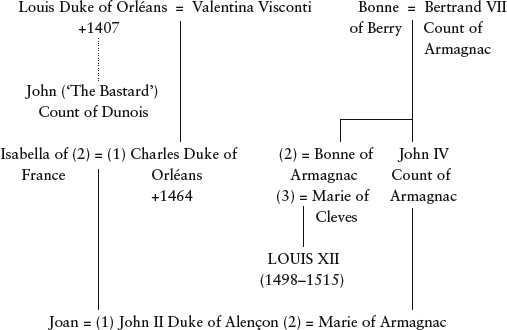Joan of Arc (36 page)

1. Valois and Plantagenet




The chief source of information 150 years after its publication is Jules Quicherat (ed.),
Procès de condamnation et de réhabilitation de Jeanne d’Arc, dite La Pucelle: publiés pour la première fois d’après les manuscrits de la Bibliothèque royale, suivis de tous les documents historiques qu’on a pu réunir, et accompagnés de notes et d’éclaircissements
(J. Renouard, Paris, 1841–9). Since the end of the royal monarchy the Bibliothèque
royale
has become
nationale
; and other manuscripts have been found elsewhere. Quicherat’s volumes treat of: vol. 1, the process of condemnation; vol. 2, the preliminaries to the process of rehabilitation not used in the eventual process, chapters 1–4 of the process; vol. 3, the process continued, chapters 5–9; opinions published in Joan’s life; vol. 4, chroniclers and historians of the fifteenth century; vol. 5, contemporary poets, documents, etc.
The first three volumes of Quicherat have been almost replaced by two more editions: Pierre Tisset and Yvonne Lanhers (eds),
Jeanne, d’Arc, Procès de condamnation
, vols 1–3 (C. Klincksieck, Paris, 1960, 1970, 1971). These books deal with the 1431 trial. P. Duparc (ed.),
Procès en nullité de la condamnation
, vols 1–4 (C. Klincksieck, Paris, 1977, 1979, 1983, 1986, 1988). These deal with most of the process Duparc calls a process of nullification, but some of the material in Quicherat is not included.
English translations are available on the Internet and, until I had access to the three editions mentioned above, I had to rely on such translations. Their style is dated and in the case of the process of nullification they conceal the boring way in which the evidence was recorded by trained lawyers; and they omit passages – in the case of d’Aulon a crucial passage that was thought indelicate. I have tried to bring the translations into line with the originals, but it is often hard to change words. If Joan was called ‘
perniciosa, seditiosa et haeretica
’, it is difficult to avoid saying that she was considered ‘pernicious, seditious and a (or an) heretic’. For her original French there is no substitute.
For anyone with the time and the requisite languages, the discussions on the documents in Quicherat, Tisset and Lanhers, and Duparc are well worth reading.
Between the First and Second World wars, the leading Johannic scholar, an expert on the whole period of Valois rule, was Pierre Champion. He edited the nullification trial documents, which he called, as was normal then, the rehabilitation trial. He also wrote a specialised study of the fifteenth-century documents for a series called the Bibliothèque du XVe siècle:
Notice des manuscrits du Procès de réhabilitation de Janne d’Arc
(Bibliothèque du XVe siècle, Paris, 1930).
Prologue: the Limits of History
| 1 | For this and what follows, see Pierre Tisset and Yvonne Lanhers (eds), Jeanne d’Arc, Procès de condamnation , vol. 1 (C. Klincksieck, Paris, 1960). |
| 2 | In the chapter ‘The Wicked Womb’ of The Female Eunuch (Flamingo Harper Collins, London, 2003, pp. 54–6) Germaine Greer discusses the classical and Renaissance theory of hysteria, which influenced early psychoanalysis. For the discussion of possible signs of hysteria in Joan see below. |
1: A Prophetess to the Rescue
| 1 | Pierre Tisset and Yvonne Lanhers (eds), Jeanne, d’Arc, Procès de condamnation , vol. 1 (C. Klincksieck, Paris, 1960). TLI, pp. 221–2l. |
| 2 | Jules Quicherat (ed.), Procès de condamnation et de réhabilitation de Jeanne d’Arc, dite La Pucelle: publiés pour la première fois d’après les manuscrits de la Bibliothèque royale, suivis de tous les documents historiques qu’on a pu réunir, et accompagnés de notes et éclaircissements , vol. 5 (J. Renouard, Paris, 1849), pp. 156–9. The text is in German; Quicherat thought it was translated from Latin. A Latin original has been found. |
| 3 | P. Duparc (ed.), Procès en nullité de la condamnation , vol. 4, p. 472. |
| 4 | Quicherat (ed.), Procès de condamnation, vol. 4, p. 503. The Inquisitor’s name was Johann Nider. |
| 5 | Desmond Seward, The Hundred Years War (London, Constable, 1996, pp. 6–17). |
2: What Need of the Maid?
| 1 | Duparc (ed.), Procès en nullité de la condamnation , vol. 1, p. 296. |
3: Victory at Orléans and Reims
| 1 | Duparc (ed.), Procès en nullité de la condamnation , vol. 1, p. 318. |
| 2 | Quicherat (ed.), Procès de condamnation , vol. 4, p. 165. |
| 3 | Ibid. , vol. 4, p. 12. |
| 4 | Duparc (ed.), Procès en nullité de la condamnation , vol. 1, p. 385. |
| 5 | Quicherat (ed.), Procès de condamnation , vol. 5, pp. 287–8. |
| 6 | For here and what follows, see ibid ., vol. 4. |
4: Defeats and Capture
| 1 | Quicherat (ed.), Procès de condamnation , vol. 5, pp. 96–8. |
5: Coming to Trial
| 1 | Quicherat (ed.), Procès de condamnation , vol. 5, p. 167. |
6: The Preparatory Trial
| 1 | For here and what follows, see Duparc (ed.), Procès en nullité de la condamnation , vol. 1. |
7: The Ordinary Trial
| 1 | For here and what follows, see Duparc (ed.), Procès en nullité de la condamnation , vol. 1. |
8: The Maid’s Death
| 1 | For here and what follows, see Duparc (ed.), Procès en nullité de la condamnation , vol. 1. |
9: The King on Trial
| 1 | This is based on the 1623 Folio text of Henry V , Act 4, scene 1, 244–6, 264–75. |
10: National Salvation
| 1 | Quicherat (ed.), Procès de condamnation , vol. 3, p. 391. |
| 2 | Ibid ., vol. 4, p. 156. |
| 3 | Ibid ., vol. 3, p. 392. |
| 4 | Duparc (ed.), Procès en nullité de la condamnation , vol. 2, p. 208. This quotation comes from a disquisition by Thomas Basin, a contemporary of Joan who was an eminent Church and civil lawyer, Bishop of Lisieux and critical biographer of Charles VII. The context of the quotation is a discussion of Joan’s use of male costume, which shows that in order to defend Joan’s behaviour a favourable cleric had to have recourse to a careful distinction between the public law of God, which applies to everyone, and the private law of God, which applies to a particular holy individual. This distinction is already present in the theology of the most influential of all medieval theologians, St Thomas Aquinas. See the essay by Jane Marie Pinzino in the collection of essays edited by Ann W. Astell and Bonnie Wheeler, Joan of Arc and Spirituality (Basingstoke and New York, Palgrave Macmillan, 2003). |
11: The Alliance of 1435
| 1 | As Joan’s life on earth moved to its close, in Ghent van Eyck had been finishing off his brother’s vision of heaven, The Adoration of the Lamb . |
| 2 | Duparc (ed.), Procès en nullité de la condamnation , vol. 1, p. 388. |
13: Voices in Defence
| 1 | For this and following quotations from Christine de Pisan, see Angus J. Kennedy, and Kenneth Varty (eds), Christine de Pisan, Ditié de Jehanne d’Arc (Oxford, Oxford University Press, 1977). |
15: Witnesses to the Life
| 1 | For this and what follows, see Duparc (ed.), Procès en nullité de la condamnation , vol. 1. |
16: Witnesses to the Trial
| 1 | For this and what follows, see Quicherat, (ed.), Procès de condamnation , vol. 2. |
| 2 | For this and what follows, see Duparc (ed.), Procès en nullité de la condamnation , vol. 1. |
17: Verdict and Rehabilitation
| 1 | Duparc (ed.), Procès en nullité de la condamnation , vol. 1. |
| 2 | François Villon, Ballade des Dames du Temps Jadis , in Lucas, St John, The Oxford Book of French Verse (Oxford, Clarendon Press, 1908), p. 31. |
18: History, Legend and Myth
| 1 | See G.B. Shaw, Saint Joan (London, Penguin, 2001), preface, pp. 19, 23–4. |
| 2 | See www.scuttlebuttsmallchow.com/joanarc.hltm on the subject of Americans and Joan of Arc in the First World War. |
| 3 | Louis-Maurice Boutet de Monvel, Jeanne d’Arc (Paris, Plon-Nourrit, 1896). |
19: Early Accounts, Partial Histories
| 1 | For this and what follows, see Quicherat (ed.), Procès de condamnation . |
| 2 | Daniel Rankin and Claire Quintal (trans.), The First Biography of Joan of Arc: with the Chronicle Record of a Contemporary Account (Pittsburgh, University of Pittsburgh, 1964), pp. 54–64. |
| 3 | Dominique Goy-Blanquet in idem (ed.), Joan of Arc, a Saint for all Seasons (Aldershot, Hampshire and Burlington, Vermont, 2003) p. 9. |
